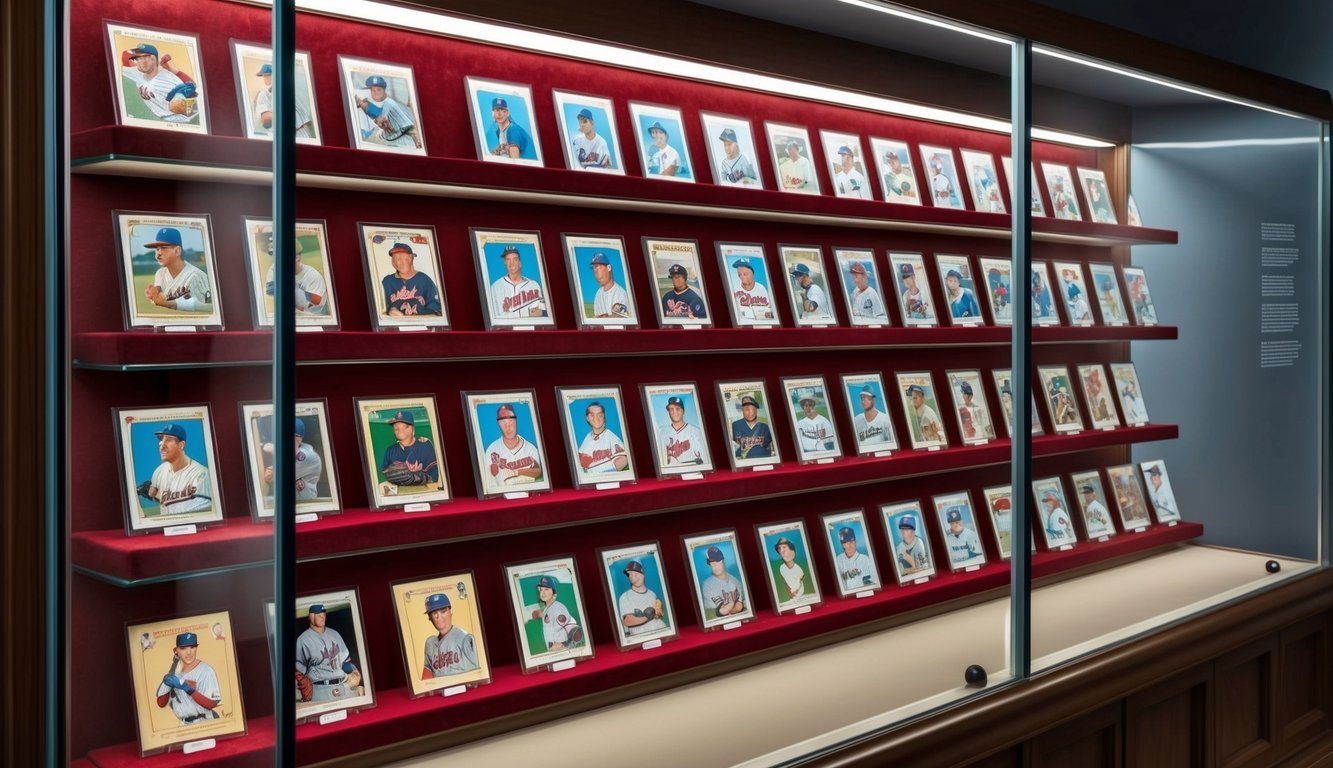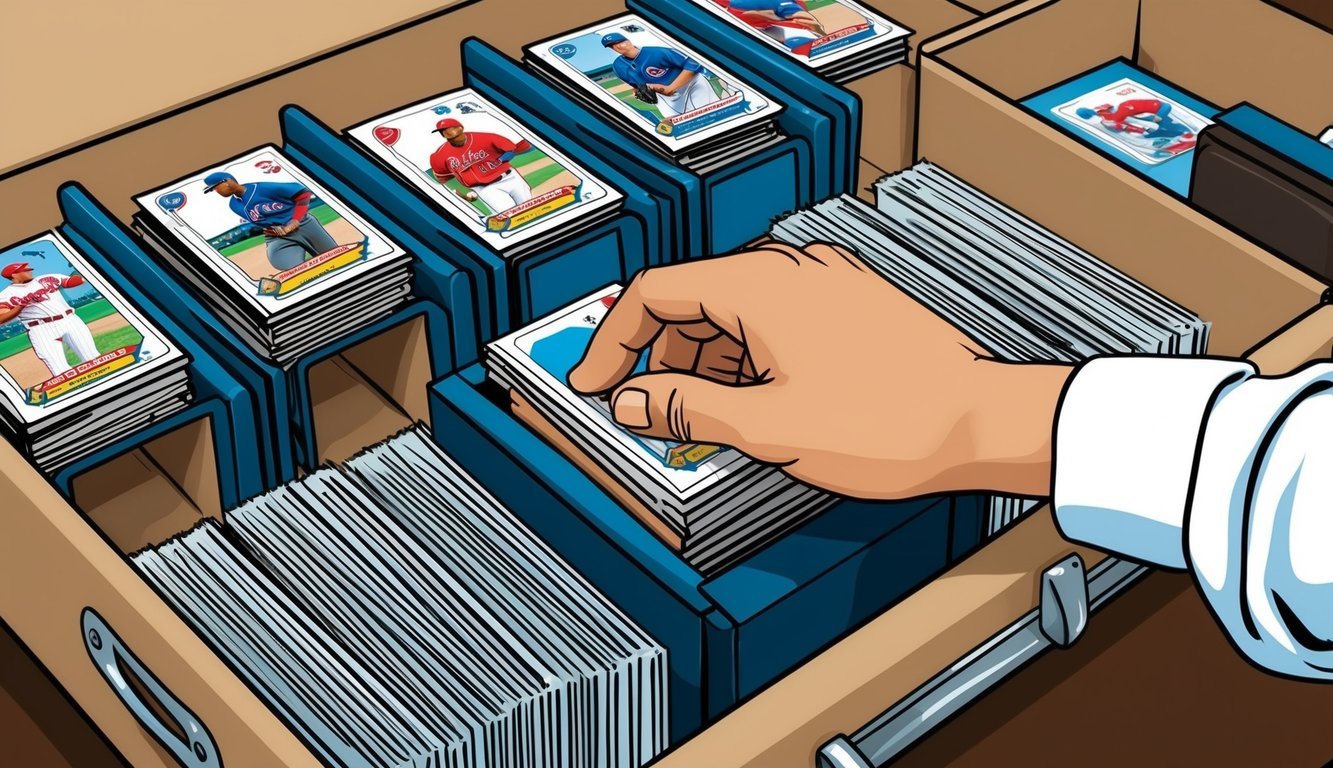Baseball cards have captivated collectors for generations.
These small pieces of cardboard hold immense value, both sentimental and monetary.
From vintage rarities to modern limited editions, the world of baseball card collecting offers something for everyone.
The T206 Honus Wagner holds the title for the most valuable baseball card ever sold.
It fetched an astounding $7.25 million at auction in 2022. This card’s scarcity and the legendary status of its subject make it the crown jewel of any collection.
Other highly sought-after cards feature iconic players like Mickey Mantle, Babe Ruth, and Willie Mays.
Collecting baseball cards can be a thrilling hobby and a potentially lucrative investment.
With careful research and a keen eye for quality, enthusiasts can build impressive collections that celebrate the rich history of America’s pastime.
Moreover, collectors often find joy in pursuing rare cards that tell unique stories about players and their achievements.
For instance, a common question among fans is how many baseballs in a game are typically used, highlighting the intricacies of the sport and its memorabilia.
This connection between the game itself and the collectibles brings an added layer of excitement to the hobby, making each card a piece of history waiting to be appreciated.
Whether you’re drawn to the nostalgia of vintage cards or the excitement of new releases, the world of baseball card collecting continues to evolve and inspire fans of all ages.
The Evolution of Collectible Baseball Cards
Baseball cards have transformed from simple promotional items to valuable collectibles over the past 150 years.
Their evolution mirrors the growth of America’s pastime and the sports memorabilia industry.
Early Beginnings and Tobacco Cards
In the late 1800s, tobacco companies began including baseball cards in cigarette packs as stiffeners.
These early cards featured sepia-toned photographs or color lithographs of players.
American Tobacco Company’s T206 series, produced from 1909 to 1911, became iconic.
The T206 Honus Wagner card, in particular, gained legendary status due to its rarity.
Candy and gum manufacturers soon followed suit, producing their own baseball cards.
This shift made the cards more accessible to younger fans.
The Rise of Card Manufacturers
The 1930s and 1940s saw the emergence of dedicated card manufacturers.
Goudey Gum Company and Bowman led the way, introducing innovative designs and higher quality printing.
In 1952, Topps launched its first major set, revolutionizing the industry.
Their large, colorful cards became the new standard.
Topps dominated the market for decades, producing annual sets that captured baseball history.
Fleer and Donruss entered the market in the 1980s, bringing competition and new designs.
This era saw explosive growth in card collecting as a hobby.
Modern Era and Technological Advancements
The 1990s brought significant changes to baseball cards.
Upper Deck introduced premium cards with holograms and high-quality photography.
Limited edition inserts and autographed cards became highly sought after.
Digital printing allowed for more intricate designs and special effects.
Manufacturers began using game-worn jersey pieces and bat fragments in cards.
Today, baseball cards have entered the digital realm.
Companies offer virtual trading cards and blockchain-based collectibles.
These innovations allow for instant transactions and unique ownership verification.
Physical cards remain popular, with manufacturers using cutting-edge printing techniques to create eye-catching designs.
The focus has shifted towards limited production runs and high-end collectibles.
Identifying Valuable Baseball Cards
Determining the value of baseball cards involves several key factors.
Collectors and enthusiasts should consider rarity, condition, and historical significance when assessing potential worth.
Rarity and Scarcity
Rare cards are often the most valuable.
Limited print runs or cards with production errors can significantly increase value.
The 1952 Topps #311 Mickey Mantle is a prime example of a scarce and highly sought-after card.
Cards from older sets, especially those from the pre-war era, tend to be rarer.
This scarcity drives up their worth in the collector’s market.
Regional issues and test prints are typically produced in smaller quantities, making them more valuable to collectors.
Condition and Grading
The physical state of a card greatly impacts its value.
Professional grading services like PSA evaluate cards based on factors such as centering, corners, edges, and surface quality.
A card in pristine condition can be worth significantly more than the same card in poor condition.
For instance, a PSA 10 (Gem Mint) 1933 Goudey Babe Ruth card would command a premium price.
Graded cards often fetch higher prices due to the assurance of authenticity and condition they provide to buyers.
Historical Significance
Cards featuring legendary players or milestone moments in baseball history are typically more valuable.
Rookie cards of Hall of Famers are especially prized by collectors.
The 1933 Goudey Babe Ruth and 1952 Topps Mickey Mantle are examples of cards that combine historical importance with rarity.
Cards from championship seasons or those depicting record-breaking achievements can also carry higher values.
Price guides can help determine a card’s worth, but market trends and collector demand ultimately drive prices.
It’s important to research recent sales of similar cards to get an accurate estimate of value.
Most Coveted Baseball Cards

Baseball card collectors treasure certain rare and iconic cards for their historical significance and connection to legendary players.
These coveted pieces often feature milestone moments or early appearances of baseball greats.
Iconic Vintage Cards
The T206 Honus Wagner card stands as one of the most sought-after in the hobby.
Produced from 1909 to 1911, its scarcity stems from Wagner’s request to halt production.
The 1914 Baltimore News #9 Babe Ruth rookie card is another prized possession.
It showcases the young Ruth as a minor league pitcher before his Major League debut.
The 1933 Goudey #181 Babe Ruth card captures the Sultan of Swat in his prime.
Its art deco style and vibrant colors make it a favorite among collectors.
Another gem is the 1916 M101-4 Sporting News #151 Babe Ruth rookie card, featuring the Bambino as a young Red Sox pitcher.
Top Players and Their Milestone Cards
Mickey Mantle‘s 1952 Topps card is a cornerstone of many collections.
Though not his true rookie card, it’s widely considered his most valuable.
The 1955 Topps #164 Roberto Clemente rookie card celebrates the start of the Puerto Rican superstar’s career.
Derek Jeter’s 1993 Upper Deck SP rookie card is a modern classic.
Its foil design and Jeter’s youthful image make it highly desirable.
Nolan Ryan’s 1968 Topps rookie card is another fan favorite, showcasing the future strikeout king in his early days.
These cards represent key moments in baseball history and the careers of legendary players.
Their rarity and connection to the sport’s greats drive their value and appeal among collectors.
Collecting Strategies and Maintaining Collections

Building a diverse baseball card collection and preserving its value requires careful planning and proper storage techniques.
Collectors can employ various strategies to enhance their portfolios while ensuring their prized possessions remain in pristine condition for years to come.
Building a Diverse Portfolio
Start by focusing on a mix of vintage and modern cards.
Vintage Topps sets from the 1950s and 1960s offer historical value, while modern chrome cards provide eye-catching aesthetics.
Consider collecting rookie cards of promising players, as these often appreciate in value over time.
Attend card shows and join online communities to network with other collectors.
This can lead to trade opportunities and insider knowledge about upcoming releases or undervalued cards.
Set a budget and stick to it.
Prioritize quality over quantity, especially for high-value cards.
Graded cards from reputable services can offer more security in your investment.
Preservation and Storage
Proper storage is crucial for maintaining card condition.
Use penny sleeves and top loaders for individual cards, especially valuable ones.
For sets or large quantities, invest in binders with acid-free pages or storage boxes designed specifically for baseball cards.
Keep cards away from direct sunlight, heat, and humidity.
Maintain a consistent room temperature and low humidity level where you store your collection.
Handle cards with clean, dry hands or wear cotton gloves.
When displaying cards, use UV-protective cases to prevent fading.
Regularly inspect your collection for any signs of damage or deterioration.
Consider getting valuable cards professionally graded to protect and potentially increase their worth.
Create a digital inventory of your collection.
This helps with organization and insurance purposes, ensuring you have a record of your valuable baseball memorabilia.
Navigating the Baseball Card Market

The baseball card market offers exciting opportunities for collectors and investors.
Staying informed about market trends and utilizing online platforms can help enthusiasts make smart decisions.
Online Marketplaces and Auctions
eBay remains a popular platform for buying and selling baseball cards.
The site’s vast selection and competitive pricing make it a go-to destination for many collectors.
Other online marketplaces like COMC and Beckett Marketplace also offer extensive inventories.
Auction houses specializing in sports memorabilia host regular events featuring rare and valuable cards.
These auctions often showcase high-end items and can attract serious collectors and investors.
Social media platforms have emerged as informal marketplaces.
Facebook groups and Instagram accounts dedicated to card trading allow collectors to connect directly and make deals.
Understanding Market Trends
Baseball card prices fluctuate based on various factors.
These include player performance, team success, and historical significance.
Rookie cards of rising stars tend to see rapid price increases during breakout seasons.
Some market prices can be volatile.
For example, some cards experience significant drops after initial hype fades.
Collectors should research recent sales data to gauge current market values accurately.
Grading services play a crucial role in determining card values.
High-grade examples of popular cards often command premium prices.
Collectors should familiarize themselves with grading scales and their impact on pricing.
Seasonal trends also affect the market.
Interest typically peaks during the baseball season, with prices often cooling during the off-season.
This cycle can create buying opportunities for savvy collectors.
